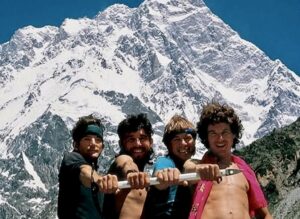Some of history’s most commendable outdoor sporting moments happened wearing unlikely attire. When women climbed mountains at the dawn of the century, they wore cumbersome dresses. Early kayakers wrapped themselves in sealskin.
Sport is not exempt from fashion faux pas, either. Neon-clad skiers in the 1980s are remembered fondly for their eye-watering brightness and frenetic graphics.
Prehistoric outerwear

Reproduction of Otzi the Similaun Man in the South Tyrol Museum of Archaeology, South Tyrol. Photo: Shutterstock
There was once a time when outdoor clothing selection was limited. Nowadays outdoor enthusiasts can walk into any store and make color or style selections to suit personal tastes. But it wasn’t always that way.
In 1991, the mummified remains of an ancient climber were uncovered high in the Alps. The significant recovery provided historical insight into the clothing of early summiters. Back then, the wilderness and the creatures in it were our only source of cover. The selection and tech were limited.

Image: Outdoor Recreating Archive, Utah State University
“Otzi” perished at 3,210m on the east ridge of Fineilspitze in the Ötztal Alps. Archaeologists rebuilt his replica, piecing together his attire.
At the time of his death, he wore a woven grass mantle, a coat, a sheepskin loincloth, and goatskin leggings. A leather chin strap tethered his bearskin cap. Moisture-absorbing grass filled his boots. Otzi’s getup was absolutely state-of-the-art — for 3230 BC.

Henry Morton Stanley in a pith helmet, de rigueur for every 19th-century tropical explorer.
The 1700s-1800s
A lot changed between Otzi’s ill-fated climb and the 1786 Mont Blanc summit of Jacques Balmat and Michel Paccard. By contrast, Balmat and Paccard had already begun using layering as insulation from the elements. They wore oversized wool coats, waistcoats, tall leather boots, and layers of stockings. As temperatures rose, they removed layers to cool off, just like people today.
But dampness makes garments heavy. Such clothing was warm and readily available, but nimble it was not.
In the late 1870s, mountaineering also became a women’s pursuit. But social requirements meant women had to wear dresses. They were usually made from light wool or alpaca. Earthy colors mimicked Otzi’s. They might seem bland by today’s standards, but fashion wasn’t a thing — at least outdoors — back then.
It wasn’t just mountaineers who wore cumbersome clothing in unlikely places. Early kayakers around the Pacific Rim wore kamleika. The long, parka-like outer shell was often made from waterproof bands of cured bear or seal intestine.

A kamleika at the Royal Albert Memorial Museum & Art Gallery. Photo: Commons
To make a kamleika, kayakers used animal gut, which they soaked in fresh water to clean and soften the tissue. Once ready, the intestine was cut into bands, dried, and sewn together to form a waterproof outer. Cleverly, a single garment consisted of a hood, padded jacket, and skirt.
Pacific Northwest kayakers soon added the bentwood hat to their ensemble. The ornately decorated headpiece, trimmed with sea lion whiskers, brought color and fashion to the otherwise lackluster kit.
Around this time, pointed wool hats came into fashion among skiers. The ski cap was an early mark of skiing culture’s proclivity to blend fashion with function.

A 19th-century Greenland Inuit man in sealskin boots and bearskin pants. Polar bear pants are still a sign of status among hunters in Northwest Greenland.

British naval polar explorers still dressed formally on board ship. Above, George Nares (centre) of the 1875-6 British Arctic Expedition.
The 1900s-1910s
When transportation improved, so did exploring new destinations. Holidays in the Alps meant that climbing became more popular, but attire hadn’t quite caught up with demand. Women skied wearing woolen, ankle-length skirts. Specialist clothing was mostly hewn from tightly woven cotton. It was warm and often windproof but susceptible to absorbing water.
And though a number of new brands rose in the first two decades of the 20th century, apparel stayed much the same during this period.

Born in Dublin in 1860, Elizabeth Hawkins Whitshed was an Irish pioneer of mountaineering. In 1907, she became the first president of the Ladies Alpine Club. Photo: Commons
One notable exception to the lull was the invention of the first functional zipper by Gideon Sundback in 1913. The stroke of ingenuity forever altered clothing, outerwear, and gear. Suddenly, not everything had to be a pullover or linked together with cumbersome buttons.
The 1920s-1930s
Perhaps a casualty of the World War and Great Depression, outdoor apparel remained largely unchanged through the late aughts and into the early 1920s. For example, the 1921 Everest Party wore tweed, Norfolk jackets, and camel hair coats.

A motley-looking crew, though all well-born gentlemen. The 1921 Everest Expedition. Photo: Commons
That said, the 1920s were a heyday for wax and rubber engineering, prized for their water repellency. Though imperfect (wax and rubber coatings ramped up waterproofness but occluded airflow, blocking perspiration in).
Perhaps inspired by flapperism, the ’20s were a defining era for sportswomen. Female skiers ditched their bulky, inefficient skirts during this period. Freedom and comfort were no longer just for men.

Skier, mid-1920s. Photo: Commons
A turning point for ski wear came along in 1924. The first Winter Olympics popularized skiing and specialist garments were designed for functionality. Women began skiing in Norwegian trousers (baggier at the top, with cinched angles) paired with a tailored jacket, inspired by the pilot’s uniform.
When George Mallory’s body was discovered after his ill-fated 1924 Everest summit, he was wearing gabardine, wool, cotton, and silk. It was the first sign of what alpinists and mountaineers would wear in the modern age. The lighter, blended fabrics boasted dynamic performance features (airflow, insulation, moisture-wicking) and signaled a positive turn away from the sport’s traditional layers.

Andrew Irvine and George Mallory, circa 1924. Photo: Commons
The year 1936 marked the invention of the goose-down jacket, replacing lambswool as a lightweight alternative. It revolutionized the ski slopes and nicely accommodated the advances in open chairlifts.
In 1937, climbing reached new heights with the entry of the Vibram rubber mountaineering sole. Grippy even in the cold, the unique rubber colloid was also relatively easy to mold, enabling new footwear shapes and specialized designs for different applications.
The 1940s-1950s
Industry improvements in the 1940s and 1950s primarily focused on gear, but certain innovations bled into clothing.
Velcro (1941), mass-produced Ventile fabric (1943), and synthetic fill (1950) all came entered the scene in this era. 1951 saw zippers explode, all thanks to RiRi’s invention of injection-molded zipper teeth. And in 1952, Gerry engineered the first-ever cordlock toggle — a fixture that would soon adorn the hems of all types of outerwear.
According to a report by Filson, “World War II and the ensuing years saw better oxygen gear, an endless supply of surplus nylon ropes, and cheap pitons.”

Photo: International Women’s Club Rotterdam
In terms of maritime and naval apparel, 1949 was notable. Jacob Jacobsen, who had innovated Norwegian wool (a fishermen’s favorite) at the turn of the century, saw a need for lighter wool apparel with lower water absorption. To foster a solution, Jacobsen partnered with Captain Henrik Bruun. Captain Bruun suggested knitting a mesh fabric out of cotton to allow more air to pass through. Jacobsen knitted up a mesh prototype which Bruun tested out on his soldiers stationed in the Norwegian alpine. The garment was wildly effective against cold, moisture, and gravity.

In 1953, Edmund Hillary shows off the innovative new mesh knit “health shirt” design by Jacob Jacobsen. Photo: Commons
1949 was a similarly incendiary year for climbers — Emile Bourdonneau and Pierre Alain designed the first climbing slipper. It looked bizarre — like a boxing shoe gone wild. And it would be the slipper by which future generations of hyper-specialized climbing shoes sprang forth.
In 1953, Brynje was recruited by Englishmen John Hunt to create fast and light “health shirts” for an upcoming Everest expedition. When Sir Edmund Hillary and Tenzing Norgay stood atop the world’s highest peak on May 29, 1953, they did so with health shirts on. The expedition did wonders for Brynje’s design, and soon the shirt fell into the hands of sports stars like boxer Ingemar Johansson.

1953: Tenzing Norgay and Edmund Hillary after the first ascent of Mount Everest. Photo: Commons
Then, in 1959, chemist Joseph Shivers introduced a fabric that could stretch more than 100 times beyond its form before snapping back into shape: Lycra. The hyper synthetic, versatile material took to snow sports like wildfire. Skiwear quickly became stretchy, tight, and high fashion. It wouldn’t be long until the outcasts of climbing employed Lycra’s dynamic fit and bold, bright applications.
The 1960s-1970s
In 1961, Helly Hansen conceived of the “W” pile fleece garments, targeted at professional and casual skiers. The “W” line remains a sturdy staple of powder hounds 60 years later.
Until the late 1960s, outdoor garments consisted of cotton, leather, silk, and wool. Down filling was still reserved for major Himalayan expeditions.
According to the Go Out Project, all of those materials had great limitations. “[They] either absorbed humidity very easily, as it was the case of wool, cotton, silk, and down, or they were far too heavy and not breathable, like leather.”
The synthesis of synthetic fibers from petroleum derivatives made clothing lighter and more resistant to water and wind. Blends of synthetic and natural fibers led to fabrics that combined the best of both worlds.

1963 Willi Unsoeld and Barry Bishop on Everest’s West Ridge. Photo: The Mountaineers/Tom Hornbein
In 1965 Sierra Designs’ iconic 60/40 Mountain Parka was born. The parka sparked similar designs from competitors, and the style is now associated more with high-elevation activity than any single brand.

Image: Outdoor Recreation Archive, Utah State University
The advent of waterproof coatings and waterproof/breathable laminates in the 1970s led to a further evolutionary step in mountaineering attire.
In 1970, Gore-Tex changed the game for clothiers and gear manufacturers alike. That year, Bob Gore secured a patent on the application of thinly stretched PTFE (better known as Teflon) to create a waterproof membrane. Within a couple of years, Gore-Tex material was on its way to achieving household name status.

1977 Gore-Tex ad. Gore-Tex took the outdoor industry by storm in the 1970s. Photo: Commons
Around that time, climber and Patagonia founder Yvon Chouinard, along with a handful of collaborators, developed the synthetic pile sweater for mountaineering. The first generation of synthetic pile sweaters comprised the same material found in toilet seat covers. The introduction of the light, highly insulated, quick-drying design came just as the fur market was bottoming out, and they outperformed traditional wool sweaters. The new sweater drastically reduced bulk and the need for multiple layers. These traits took the market by storm, and the synthetic pile sweater quickly became one of the most successful outdoor garments ever.
The synthetic fibers were especially easy to dye, a feature that allowed clothing brands to offer colors and patterns of all varieties. This worked well with the bright, bold mainstream trends, and brought vibrance to outdoor clothing in ways never previously possible. Funk, groove, flower power, and rainbows were now on offer to the adventurous.

1975 Habeler and Messner after the first ascent of the Gasherbrum I. Photo: Commons
1975 was a helluva year for adventure garment components. ITW Nexus granted a patent for the first side-release plastic buckle. Buffalo Systems rolled out Double P (pile/Pertex) garments. Berghaus released the full coverage Yeti gaiter (complete with a rubber rand).
And, perhaps most stylistically distinct of all 1975 innovations: Rohan’s Tundra introduced the very first softshell, a close-fitting stretch jacket that was both wind and showerproof.

Knickers, knee socks, wooden skis…and is that an early red version of TNF’s classic Back Magic pack? Image: Outdoor Recreating Archive, Utah State University
The 1980s-1990s
By the 1980s ski fashion hit a pinnacle of outlandish colors, patterns, and styles. No tone was too bright, no pattern combination too wacky. Men and women both wore fluorescent neon snowsuits. Much of this trend was thanks to the previous decade’s entre of Gore-Tex, which allowed ski wear to be lightweight yet weatherproof.

Lycra, loud colors, and oversized tops dominated 1980s ski culture. Photo: Commons
Mountaineers managed to evade the loudest of the 1980s neon saga with earth-toned snowsuits and large goggles.
In terms of technical trends, again, Chouinard and his partners struck gold with the emergence of synthetic long underwear in 1980. The ultralight, hydrophobic alternative to cotton long johns enjoyed similar success to that of Chouinard’s sweater. Shortly after developing it, the renowned climber formed Patagonia.

A Berghaus photoshoot in the mid-80s. Photo: Berghaus
In the climbing segment, the trend toward cragging was met in 1980 by Boreal and Nike. That’s the year Boreal launched the Fire — climbing’s first “sticky rubber” shoe. Nike handled the hikes to and from climbing walls by developing the very first approach shoe, the Lava Dome.

Andy Pollit scales a wall in 1980s-apropos clothing. Lycra: check. Vibrant colors: check. Headband: optional but recommended. Photo: Commons
Five Ten followed Nike’s lead in 1985, introducing the Five Tennie approach shoe. The Five Tennie featured the brand’s proprietary (and still popular today) Stealth climbing rubber sole.
In 1992, Scarpa and Black Diamond collaborated on skiing’s first plastic telemark boot. Bold 1990s colors and graphics flocked the boot’s distinctive, sharp form factor. To this day, it’s easy to tell a Scarpa boot from the rest.

Plastic telemark ski boot, circa 1992. Photo: Geartrade
The 2000s-Present
The 2000s saw a new rise in environmental concerns. In 2007, Nau became the first brand to fully heed the call, introducing a complete line of eco-friendly outdoor apparel.
This remains a major trend today and has cultivated an almost competitive milieu among outdoor clothing brands. Especially in today’s burgeoning market, the race to offer the most earth-friendly, sustainable option is on and seemingly endless.

Image: Outdoor Recreating Archive, Utah State University
While this vibe has significantly altered the way that companies manufacture and package items, the trend is as visually apparent. Revivals of older styles emerge every so often (take the classic Five Tennie approach shoe as an example), but the looks of high-tech garments seem largely unaltered.

Image: Outdoor Recreation Archive, Utah State University
One notable upcoming trend: off-white or near-white outdoor gear. Brands like Arc’teryx and Patagonia are turning towards simpler and less caustic production methods. The most visually obvious change, and something we expect to start seeing a lot of in the coming seasons, is undyed, natural fabric.

Some contemporary outdoor clothing like the Columbia jacket seen here is undyed to reduce water and energy usage during manufacture. Photo: Columbia
The exclusion of dyes reduces the raw materials and water consumed in the manufacturing process. The resulting products, therefore, get their hues from undyed fibers. And since most apparel-friendly natural fibers (bamboo, cotton, wool) are innately off-white, so too is the outdoor apparel spun from them.
As a final treat, here is Glamour magazine’s jaunty take on ski clothing through the decades.
What did we miss?
Are there any outrageous or noteworthy flashpoints in outdoor clothing history that we missed? Let us know in the comments!






